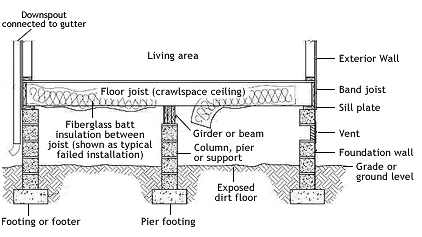Many of our customers and potential customers constantly ask, “What is the purpose of a crawl space?” The primary purpose of a crawlspace is to allow easy access to plumbing, electrical and other such maintenance, repair, and installation needs. In essence, a crawlspace, as its name implies, is a variation of a basement in which one crawls around.
Some are as small as a foot in height, while others tend to be 3′ to 4′ in height. Although we occasionally encounter a concrete floor, the floor surface is often just dirt, sometimes with a thin piece of plastic on top, which is supposed to act as a vapor barrier. Crawl spaces offer an expedient and efficient way to access pipes, substructures and a variety of other areas that may be difficult or expensive to reach otherwise.

Residential Waterproofing and Vapor Proofing of the Crawl Space
To begin with, as basement waterproofing and foundation repair experts, we would like to establish the correct method of moisture control in crawl spaces and dispel the old, obsolete theories and guidelines regarding crawl space ventilation, under floor insulation, and moisture control. We are now in the 21st Century and it is time for our construction industry to move into this Century as well. Innovations and new technological advances in construction, foundations, and basement waterproofing have spread to these same advances in crawl space waterproofing and moisture control.
For decades, because it was mandated by the International Residential Code, contractors, home builders, municipal building inspectors, and homeowners alike have believed (or been led to believe) that a crawl space needs to have exterior vents on opposing walls. The original intention of these vents was so that air may flow through a crawl space, from one vent to the other. The theory here is that this will draw out any extra humidity from the enclosed space.
In fact, many crawl space vent and vent fan manufacturers would have you continue this belief. However, recent studies show that vents in a crawl space actually create a very different effect, which is known and now accepted as the ‘Stack Effect’. Stack effect is defined as the movement of air into and out of buildings, chimneys, flue gas stacks, or other containers, and is driven by buoyancy. Buoyancy occurs due to a difference in indoor-to-outdoor air density resulting from temperature and moisture differences.
The result is either a positive or negative buoyancy force. The greater the thermal difference and the height of the structure, the greater the buoyancy force, and thus the stack effect. The stack effect is also referred to as the ‘chimney effect’, and it helps drive natural ventilation and infiltration. Since buildings are not completely or hermetically sealed (at the very minimum, there is always a ground level entrance), the stack effect causes air infiltration.
During the warmer seasons, the warmer indoor air rises up through the home or building and escapes at the top, either through open windows, or through leakage. The rising warm air reduces the pressure in the base of the building, forcing cold air to infiltrate through either open doors, windows, or other openings and leakage. During the cooling season, the stack effect is reversed, but is typically weaker due to lower temperature differences.
As a result, the cold and humidity (and mold spores and dust) from the crawl space are drawn into your home, increasing your heating costs and endangering your well-being. Ironically, the better you ventilate your crawl space, the more heat is drawn out of your home through upstairs cracks. Even in warm weather, when there is no vertical air flow drawing cold air up into your house and hot air out the upstairs, ventilating both ends of the space doesn’t actually do much for airflow or humidity.
There is nothing to draw the air through the vents, if they are both at the same level. In addition, the ventilation approach really amounts to treating the symptoms instead of curing the illness – and not doing a very good job at that. The disease, in this case, is excessive air and moisture entering the crawl space, which attracts the mold, rodents, termites, and other pest problems, along with increased condensation and excess heat transfer during colder months between the crawl space and the outdoors.
To reiterate what we said earlier, you might find that your builder, home and municipal inspectors disagree with this idea of sealing and insulating a crawl space. It goes against their conventional wisdom and it contravenes many local building codes that were written from that accepted wisdom. I had a long time convincing my partner – a master carpenter, custom homebuilder for over 25 years, general contractor, who has built entire sub-divisions – so convincing you may be difficult. Nevertheless, this is the truth.
Many people don’t really know what a crawl space is for. It is usually for plumbers, technicians and electricians to move around easily when conducting repairs. We advise you to select our crawl space waterproofing in Northern Virginia to keep your crawl space protected from water damage. You can also call us for other crawl space repairs.
You might still think that running a space heater in your crawl space will leave you with warmer feet. But you will improve the indoor air quality of your home and crawl space, resolve any moisture, mold, or rotting wood problems down below, make your whole home healthier, cut heat, air conditioning, and energy loss, and save money IF you set this out-of-date belief aside and go with what tons of research suggests is the most effective method of dealing with crawl spaces. (We have research papers and references available if you still disbelieve and would like to call and discuss this further.).